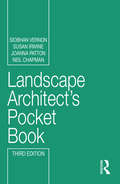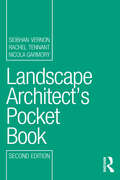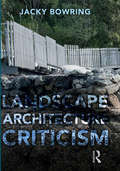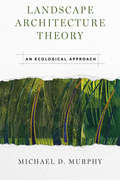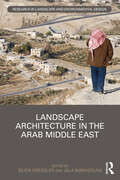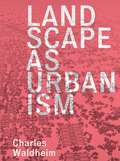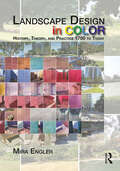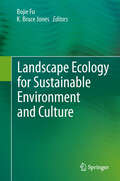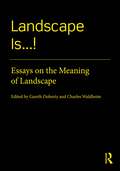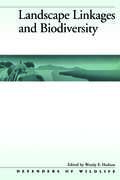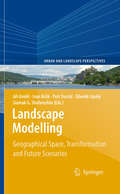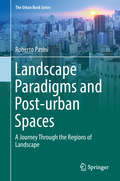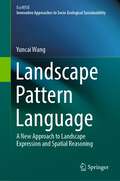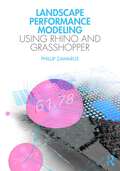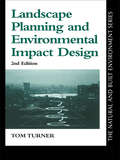- Table View
- List View
Landscape Architect's Pocket Book (Routledge Pocket Books)
by Neil Chapman Siobhan Vernon Susan Irwine Joanna PattonThis third edition of the bestselling Landscape Architect’s Pocket Book, written by leading practitioners, incorporates updates and revisions to environmental and building regulations, contracts, and a range of design guidelines including materials, SuDS, environmental impact, and landscape character assessment. The book is an indispensable tool for all landscape architects, providing a timesaving guide and first point of reference to everyday topics, both out on site and in the office. The pocket book covers all major subjects, including hard and soft landscaping, national guidelines and standards, and key planning policy and legislation. Providing concise, easy-to-read reference material, useful calculations, and instant access to a wide range of topics, it is an essential resource for landscape architects, construction industry professionals, and students.
Landscape Architect's Pocket Book (Routledge Pocket Books)
by Rachel Tennant Nicola Garmory Siobhan VernonAn indispensable tool for all landscape architects, this time-saving guide answers the most frequently asked questions in one pocket-sized volume. It is a concise, easy-to-read reference that gives instant access to a wide range of information needed on a daily basis, both out on site and in the office.Covering all the major topics, including hard landscaping, soft landscaping as well as planning and legislation, the pocket book also includes a handy glossary of important terms, useful calculations and helpful contacts. Not only an essential tool for everyday queries on British standards and procedures, this is a first point of reference for those seeking more extensive, supplementary sources of information, including websites and further publications. This new edition incorporates updates and revisions from key planning and environmental legislation, guidelines and national standards.
Landscape Architecture Criticism
by Jacky BowringLandscape Architecture Criticism offers techniques, perspectives and theories which relate to landscape architecture, a field very different from the more well-known domains of art and architectural criticism. Throughout the book, Bowring delves into questions such as, how do we know if built or unbuilt works of landscape architecture are successful? What strategies are used to measure the success or failure, and by whom? Does design criticism only come in written form? It brings together diverse perspectives on criticism in landscape architecture, establishing a substantial point of reference for approaching design critique, exploring how criticism developed within the discipline. Beginning with an introductory overview to set the framework, the book then moves on to historical perspectives, the purpose of critique, theoretical positions ranging from aesthetics, to politics and experience, unbuilt projects, techniques, and communication. Written for professionals and academics, as well as for students and instructors in landscape architecture, it includes strategies, diagrams, matrices, and full colour illustrations to prompt discussion and provide a basis for exploring design critique.
Landscape Architecture Documentation Standards: Principles, Guidelines And Best Practices
by Design WorkshopAchieve better execution with the documentation standards behind an industry-leading firm Construction Documentation Standards and Best Practices for Landscape Architectural Design offers guidelines, methods, and techniques for creating more robust project documents. Developed and authored by one of the world's leading landscape architectural firms, this material has been field tested by Design Workshop's ten offices and 150 designers to ensure completeness, practicality, and effectiveness. The book provides an overview of the entire design and construction process in the context of actual documentation, with best practice standards for design document content, format, and graphics. Readers learn how to apply these practices to serve the specific needs of different projects, gaining a comprehensive understanding of how complete documentation better serves the project as a whole. Good documentation leads to good execution, which leads to better performance from the perspectives of durability, safety, and user enjoyment. This book presents a set of standards that serve as a roadmap of the design process, helping designers provide the complete documentation that the most highly executed projects require. Discover how documentation ties into project performance Learn the best practices for documenting every stage of the process Study actual project documents serving various project needs Gain documentation insights from one of the world's top firms Design Workshop has been an industry leader since 1969, with projects ranging from resorts, to wildlife refuges, to county master plans. The value of their insight is proven by the continued high performance of their projects across the U. S. and beyond, and this book contains the standards, techniques, and actual documentation behind this success. Better outcomes require better execution, which starts with the documentation standards presented in Construction Documentation Standards and Best Practices for Landscape Architectural Design.
Landscape Architecture Theory: An Ecological Approach
by Michael MurphyFor decades, landscape architecture was driven solely by artistic sensibilities. But in these times of global change, the opportunity to reshape the world comes with a responsibility to consider how it can be resilient, fostering health and vitality for humans and nature. Landscape Architecture Theory re-examines the fundamentals of the field, offering a new approach to landscape design.Drawing on his extensive career in teaching and practice, Michael Murphy begins with an examination of influences on landscape architecture: social context, contemporary values, and the practicalities of working as a professional landscape architect. He then delves into systems and procedural theory, while making connections to ecosystem factors, human factors, utility, aesthetics, and the design process. He concludes by showing how a strong theoretical understanding can be applied to practical, every-day decision making and design work to create more holistic, sustainable, and creative landscapes.Students will take away a foundational understanding of the underpinnings of landscape architecture theory, as well as how it can be applied to real-world designs; working professionals will find stimulating insights to infuse their projects with a greater sense of purpose.
Landscape Architecture Theory: An Ecological Approach
by Michael MurphyFor decades, landscape architecture was driven solely by artistic sensibilities. But in these times of global change, the opportunity to reshape the world comes with a responsibility to consider how it can be resilient, fostering health and vitality for humans and nature. Landscape Architecture Theory re-examines the fundamentals of the field, offering a new approach to landscape design.Drawing on his extensive career in teaching and practice, Michael Murphy begins with an examination of influences on landscape architecture: social context, contemporary values, and the practicalities of working as a professional landscape architect. He then delves into systems and procedural theory, while making connections to ecosystem factors, human factors, utility, aesthetics, and the design process. He concludes by showing how a strong theoretical understanding can be applied to practical, every-day decision making and design work to create more holistic, sustainable, and creative landscapes.Students will take away a foundational understanding of the underpinnings of landscape architecture theory, as well as how it can be applied to real-world designs; working professionals will find stimulating insights to infuse their projects with a greater sense of purpose.
Landscape Architecture for Sea Level Rise: Innovative Global Solutions
by Galen D. Newman Zixu QiaoThis book assesses and illustrates innovative and practical world-wide measures for combating sea level rise from the profession of landscape architecture. The work explores how the appropriate mixture of integrated, multi-scalar flood protection mechanisms can reduce risks associated with flood events including sea level rise. Because sea level rise is a global issue, illustrative case studies performed from the United States, Korea, Australia, New Zealand, Thailand, Japan, China, and the Netherlands identify the structural (engineered), non-structural (nature-based), and hybrid mechanisms (mixed) used to combat sea level rise and increase flood resilience. The alternative flood risk reduction mechanisms are extracted and analyzed from each case study to develop and explain a set of design-based typologies to combat sea level rise which can then be applied to help proctor new and existing communities. It is important for those located within the current or future floodplain considering sea level rise and those responsible for land use, developmental, and population-related activities within these areas to strategically implement a series of integrated constructed and green infrastructure-based flood risk reduction mechanisms to adequately protect threatened areas. As a result, this book is beneficial to both academics and practitioners related to multiple design professions such as urban designers, urban planners, architects, real estate developers, and landscape architects.
Landscape Architecture in the Arab Middle East (Routledge Research in Landscape and Environmental Design)
by Jala Makhzoumi Beata DrekslerThis book explores the challenges facing landscape architecture in the Middle East. It supports the idea that landscape is a multifaceted idea, and examines landscapes architecture as an emerging profession in the region. The book also responds to the limitations of faulty translations of the English ‘landscape’ that, in turn, limit the professional potential in the region.The authors of the book see landscape as a way of beholding the world that is informed by place and culture. And because landscape is context specific, a landscape framing contextualizes a problem, be it community development, tourism, or nature conservation, to foster place and culture responsive perspectives. The nine chapters are grouped under four broad themes that reflect the multifaceted, ‘expansive’ framing that embraces landscape, natural and cultural heritage, people and livelihoods, and landscape and human rights.The authors recognize that a landscape framing is not the exclusive domain of landscape architecture, but can be applied by architects, planners, and environmentalists. The ideas advanced and issues discussed will be of interest to researchers, students, and practitioners in landscape architecture, architecture, planning, and urban design, as well as social and environmental scientists.
Landscape As Urbanism: A General Theory
by Charles WaldheimIt has become conventional to think of urbanism and landscape as opposing one another--or to think of landscape as merely providing temporary relief from urban life as shaped by buildings and infrastructure. <P><P>But, driven in part by environmental concerns, landscape has recently emerged as a model and medium for the city, with some theorists arguing that landscape architects are the urbanists of our age.
Landscape Design in Color: History, Theory, and Practice 1750 to Today
by Mira EnglerArchitects, landscape architects and urban designers experiment with color and lighting effects in their daily professional practice. Over the past decade, there has been a reinvigorated discussion on color within architectural and cultural studies. Yet, scholarly enquiry within landscape architecture has been minimal despite its important role in landscape design. This book posits that though color and lighting effects appear natural, fleeting, and difficult to comprehend, the sensory palette of built landscapes and gardens has been carefully constructed to shape our experience and evoke meaning and place character. Landscape Design in Color: History, Theory, and Practice 1750 to Today is an inquiry into the themes, theories, and debates on color and its impact on practice in Western landscape architecture over the past three centuries. Divided into three key periods, each chapter in the book looks at the use of color in the written and built work of key prominent designers. The book investigates thematic juxtapositions such as: natural and artificial; color and line; design and draftsmanship; sensation and concept; imitation and translation; deception and display; and decoration and structure, and how these have appeared, faded, disappeared, and reappeared throughout the ages. Richly designed and illustrated in full color throughout, including color palettes, this book is a must-have resource for students, scholars, and design professionals in landscape architecture and its allied disciplines.
Landscape Ecology for Sustainable Environment and Culture
by Bojie Fu Bruce Jones KClimate change and the pressures of escalating human demands on the environment have had increasing impacts on landscapes across the world. In this book, world-class scholars discuss current and pressing issues regarding the landscape, landscape ecology, social and economic development, and adaptive management. Topics include the interaction between landscapes and ecological processes, landscape modeling, the application of landscape ecology in understanding cultural landscapes, biodiversity, climate change, landscape services, landscape planning, and adaptive management to provide a comprehensive view that allows readers to form their own opinions. Professor Bojie Fu is an Academician of Chinese Academy of Sciences and Chair of scientific committee at the Research Center for Eco-Environmental Sciences, Chinese Academy of Sciences, Beijing, China. Professor K. Bruce Jones is the Executive Director for Earth and Ecosystem Sciences Division at Desert Research Institute, University of Nevada, Las Vegas, USA.
Landscape Indicators
by Claudia Cassatella Attilia PeanoIn recent years EU policy towards the 'landscape' has become better defined, whereas at the same time the notion of 'landscape' itself remains elusive. The need for indicators to evaluate and monitor the effects of landscape policies and plans is urgent. What is more, landscape is one of the components considered in environmental reporting, but unlike air, soil, or water, it is difficult to measure using quantitative methods. With studies on landscape indicators being as rare as they are, this volume is an attempt to fill the gap, dealing as it does with the definition and use of specific indicators for landscape assessment and monitoring. To tackle the diverse dimensions of the landscape (whose complexity is well known), the subject is approached by a multidisciplinary team of experts in landscape ecology, landscape history, landscape perception, regional planning, strategic environmental assessment and environmental impact assessment procedures, and multi-criteria assessment methods. Individual chapters include comparative assessments of studies conducted thus far in the EU, as well as detailed analyses of ecological, historical, perceptive, land-use, and economic ways of looking at landscape. As well as providing a rich source of references for researchers studying the landscape from a variety of perspectives, the book will be required reading for European officials involved at any level in planning or assessing the landscape or environment.
Landscape Indicators: Assessing and Monitoring Landscape Quality
by Claudia Cassatella Attilia PeanoIn recent years EU policy towards the ‘landscape’ has become better defined, whereas at the same time the notion of ‘landscape’ itself remains elusive. The need for indicators to evaluate and monitor the effects of landscape policies and plans is urgent. What is more, landscape is one of the components considered in environmental reporting, but unlike air, soil, or water, it is difficult to measure using quantitative methods.With studies on landscape indicators being as rare as they are, this volume is an attempt to fill the gap, dealing as it does with the definition and use of specific indicators for landscape assessment and monitoring. To tackle the diverse dimensions of the landscape (whose complexity is well known), the subject is approached by a multidisciplinary team of experts in landscape ecology, landscape history, landscape perception, regional planning, strategic environmental assessment and environmental impact assessment procedures, and multi-criteria assessment methods. Individual chapters include comparative assessments of studies conducted thus far in the EU, as well as detailed analyses of ecological, historical, perceptive, land-use, and economic ways of looking at landscape.As well as providing a rich source of references for researchers studying the landscape from a variety of perspectives, the book will be required reading for European officials involved at any level in planning or assessing the landscape or environment.
Landscape Is...!: Essays on the Meaning of Landscape
by Charles Waldheim Gareth DohertyLandscape Is...! examines the implicit biases and received meanings of landscape. Following on from the previous publication Is Landscape…? which examined the plural and promiscuous identities of the landscape idea, this companion volume reflects upon the diverse and multiple meanings of landscape as a discipline, profession, and medium. This book is intended for academics, researchers, and students in landscape architecture and cognate disciplines. Chapters address various overlooked aspects of landscape that develop, disturb, and diversify received understandings of the field. Framed as an inquiry into the relationship of landscape to the forms of human subjectivity, the book features contributions from leading voices who challenge the contemporary understandings of the field in relation to capital and class, race and gender, power and politics, and more.
Landscape Lab: Drawing, Perception and Design for the Next Landscape Models (Urban and Landscape Perspectives #20)
by Fabio Bianconi Marco FilippucciThis book explores the relationship between the sciences of representation and the strategy of landscape valorisation. The topic is connected to the theme of the image of the city, which is extended to the territory scale and applied to case studies in Italy’s Umbria region, where the goal is to strike a dynamic balance between cultural heritage and nature. The studies demonstrate how landscape represents an interpretive process of finding meaning, a product of the relationships between mankind and the places in which it lives. The work proceeds from the assumption that it is possible to describe these connections between environment, territory and landscape by applying the Vitruvian triad, composed of Firmitas (solidity), Utilitas (utility) and Venustas(beauty). The environment, the sum of the conditions that influence all life, represents the place’s solidity, because it guarantees its survival. In turn, territory is connected to utility, and through its etymological meaning is linked to possession, to a domain; while landscape, as an “area perceived by people”, expresses the search for beauty in a given place, the process of critically interpreting a vision.
Landscape Linkages and Biodiversity: Policies For A Sustainable Future
by Larry Harris Michael E. Soulé J. Michael Scott Wendy E. Hudson Blair Csuti Keith HayIn Landscape Linkages and Biodiversity experts explain biological diversity conservation, focusing on the need for protecting large areas of the most diverse ecosystems, and connecting those ecosystems with land corridors to allow species to move among them more easily.
Landscape Modelling
by Siamak G. Shahneshin Ivan Bičík Jiří Anděl Petr Dostál Zdeněk LipskýLandscape modelling integrates the differing perspectives of the many disciplines that deal with the landscape. It is motivated not only by the desire for scientific understanding, but also by the real-time demands of 21st century postindustrial society, which include the twin imperatives of stabilizing damaged ecosystems on the one hand, and finding effective ways to use the landscape on the other. The discipline has the specific goal of designing and assessing future scenarios of landscape development, while not losing sight of its past history, both ecological and socio-cultural. This book encompasses the interrelated disciplines of geography, landscape ecology and geoinformatics, and by drawing on their theories and methodologies introduces the concept of a living landscape with human action an inseparable part of its evolution. It offers researchers and decision-makers a number of ideas on how our landscape can best be utilized. The content reflects the need for sustainable landscape development, at the same time as considering long-term continuity as a major condition which enables us to maintain the diversity and multifunctionality of landscapes at regional and macro-regional scales. Employing advanced terminology and methods, this book provides specific results especially for scientists and landscape professionals.
Landscape Modelling and Decision Support (Innovations in Landscape Research)
by Wilfried Mirschel Vitaly V. Terleev Karl-Otto WenkelThis book contributes to a deeper understanding of landscape and regional modelling in general, and its broad range of facets with respect to various landscape parameters. It presents model approaches for a number of ecological and socio-economic landscape indicators, and also describes spatial decision support systems (DSS), frameworks, and model-based tools, which are prerequisites for deriving sustainable decision and solution strategies for the protection of comprehensively functioning landscapes. While it mainly focuses on the latest research findings in regional modelling and DSS in Europe, it also highlights the work of scientists from Russia. The book is intended for landscape modellers, scientists from various fields of landscape research, university teaching staff, and experts in landscape planning and management, landscape conservation and landscape policy.
Landscape Paradigms and Post-urban Spaces: A Journey Through the Regions of Landscape (The Urban Book Series)
by Roberto PasiniThis book presents: 1) an urban-studies panorama on the emergence of a built/landscape continuum following the anthropic expansion at the geographic scale and the consequent demise of the city/country divide; 2) an in-depth theoretical analysis of disparate landscape constructs, culminating in the proposal of a comprehensive spatial paradigm addressing both manmade and natural contexts; 3) the in-situ transcription of the proposed spatial paradigm into a landscape installation implementing a territorial narrative in the Sierra Madre Oriental of Mexico. Foreword by Peter G. Rowe and afterword by Elisa C. Cattaneo.By virtue of its openness, fluidity, and volatility, fluctuating between heterogeneity and diversity, today’s built/landscape continuum exhibits analogies with distinct notions of landscape. The book determines an open-ended classification of contemporary space-making strategies exceeding the urban and metropolitan ambit, through a comparative anatomy of global case studies ranging from hard to soft: geotechnics or applied geographies, machinic micro-ecologies, aesthetic prostheses for operative metabolism, cybernetic utopias, atmospheric assemblages, psychic spheres, creole horizons, semiotic landscapes, geopolitical landscapes, geophilosophical excavations. The proposed spatial paradigm, accommodating aggregates of artificial and living systems, physical and mental spaces, and machinic and cultural landscapes, intends to reconcile the traditionally opposed ‘scientific-cognitive-metabolist’ and ‘cultural-geophilosophical-territorialist’ visions of the landscape. The resulting model transcends the exhausted myths of urban space, metropolitanism, and their filiations, in favor of a new form of urbanity and its attributes. Parts of the work were developed in the frame of research projects of Universidad de Monterrey and Parque Ecológico Chipinque and the IDAUP of UniFE and Polis.The target audience of the book is researchers, teachers, and advanced students engaged in landscape and urban studies with a prevalent focus on theory. The book can also benefit professional and institutional audiences looking for ethical/methodological orientation.
Landscape Pattern Language: A New Approach to Landscape Expression and Spatial Reasoning (EcoWISE)
by Yuncai WangThis book presents a landscape pattern language framework for describing landscape spaces and offers a new approach to landscape expression and spatial reasoning. In addition to describing a conceptual model of landscape pattern language and its inner logical connections, the book discusses the functionality of landscape pattern language from both local and universal perspectives—effectively demonstrating that it can be used to highlight the individuality and characteristics of landscape space shaping. Given its scope, the book offers a valuable resource for all graduate students, lecturers, researchers, and practitioners in the areas of landscape architecture, landscape planning, and regional planning, especially ecological planning and design.
Landscape Performance Modeling Using Rhino and Grasshopper
by Phillip ZawarusThis is a guidebook for landscape architects to learn the fundamental practices and use of the computational software Rhino 3D and the plugin Grasshopper for parametric modeling, landscape inventory, and performative analysis. This process visually connects intangible and abstract information with physical and spatial relationships to signify the impact ecological, climate, and cultural factors have on landscape performance and decision making. Each chapter begins with a summary of the performance method and its application in different projects, outlining the expected goals from industry standard equations and operations. Chapters cover parametric modeling scripts to measure ecosystem services of stormwater management, erosion control, tree benefits, outdoor comfort, accessibility, and many others. Using photographs, tables, and parametric scripts to create qualitative and quantitative representations of landscape performance and ecosystem services, readers will learn to communicate the impact and significance of their outputs. This book will be beneficial to educators, students, and professionals interested in using computational modeling as a performance assessment and graphic visualization tool.
Landscape Planning And Environmental Impact Design
by Tom TurnerWritten for use in undergraduate and postgraduate planning courses and for those involved in all aspects of the planning process, this comprehensive textbook focuses on environmental impact assessment and design and in particular their impact on planning for the landscape.
Landscape Planning and Rural Development
by Carlo RegaThis book aims to contribute to the current debate on how to integrate rural development policies and landscape planning in rural areas. It highlights the key issues at stake and the possibilities for synergies between landscape planning and policies in light of European development policies, particularly the EU's Rural Development Policy and the Common Agricultural Policy (CAP). Case studies from different rural contexts and landscapes are provided, illustrating tools and options to make the advocated integration operational. Recommendations and guidance to policy making are proposed. The case studies presented cover 1) the use of visual assessment techniques to support landscape planning in rural areas; 2) participative applications of landscape assessment techniques in peri-urban areas; 3) multi-scale approaches to landscape management in Alpine areas and 4) the application of landscape economic evaluation to foster rural development strategies.
Landscape Planning with Ecosystem Services: Theories and Methods for Application in Europe (Landscape Series #24)
by Christina Von Haaren Andrew A. Lovett Christian AlbertHuman well-being depends in many ways on maintaining the stock of natural resources which deliver the services from which human’s benefit. However, these resources and flows of services are increasingly threatened by unsustainable and competing land uses. Particular threats exist to those public goods whose values are not well-represented in markets or whose deterioration will only affect future generations. As market forces alone are not sufficient, effective means for local and regional planning are needed in order to safeguard scarce natural resources, coordinate land uses and create sustainable landscape structures. This book argues that a solution to such challenges in Europe can be found by merging the landscape planning tradition with ecosystem services concepts. Landscape planning has strengths in recognition of public benefits and implementation mechanisms, while the ecosystem services approach makes the connection between the status of natural assets and human well-being more explicit. It can also provide an economic perspective, focused on individual preferences and benefits, which helps validate the acceptability of environmental planning goals. Thus linking landscape planning and ecosystem services provides a two-way benefit, creating a usable science to meet the needs of local and regional decision making. The book is structured around the Driving forces-Pressures-States-Impacts-Responses framework, providing an introduction to relevant concepts, methodologies and techniques. It presents a new, ecosystem services-informed, approach to landscape planning that constitutes both a framework and toolbox for students and practitioners to address the environmental and landscape challenges of 21st century Europe.
Landscape Urbanism and its Discontents
by Andrés Duany Emily TalenIn contemporary Western society, urban development is regarded as an unfortunate blight from which nature provides a much-needed respite. This apparent dichotomy ignores the interdependence between human settlement and the natural world. In fact, one of the most pressing problems facing urban theorists today is determining how to resolve the tension between the built and natural environments, in the process creating truly sustainable cities.Landscape Urbanism and its Discontents is a collection of essays exploring the debate over urban reform, now polarized around the two competing paradigms of Landscape Urbanism and the New Urbanism. Landscape Urbanism is conceived as a more ecologically based approach, while New Urbanism is more concerned with the built form. Well-known and influential urban theorists such as Andrés Duany and James Howard Kunstler delve into the impact of the tension between the two perspectives on:Smart growthNeighborhood designSustainable developmentCreating cities that are in balance with natureWhile there is significant overlap between Landscape Urbanism and the New Urbanism, the former has assumed prominence amongst most critical theorists, whereas the latter's proponents are more practically oriented. Given that these two sets of ideas are at the forefront of sustainable urban design, the analysis- and potential reconciliation-offered by Landscape Urbanism and its Discontents is long overdue.Andrés Duany is a leading proponent of the New Urbanism and is a founding principal at Duany Plater-Zyberk & Company.Emily Talen is a professor at Arizona State University and the author of four previous books on urban design.
